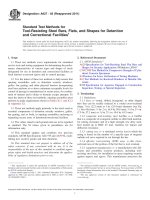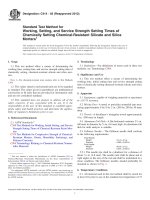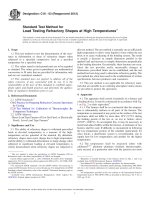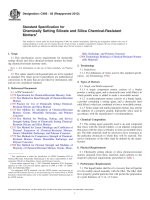Astm c 1156 03 (2011)
Bạn đang xem bản rút gọn của tài liệu. Xem và tải ngay bản đầy đủ của tài liệu tại đây (101.7 KB, 3 trang )
Designation: C1156 − 03 (Reapproved 2011)
Standard Guide for
Establishing Calibration for a Measurement Method Used to
Analyze Nuclear Fuel Cycle Materials1
This standard is issued under the fixed designation C1156; the number immediately following the designation indicates the year of
original adoption or, in the case of revision, the year of last revision. A number in parentheses indicates the year of last reapproval. A
superscript epsilon (´) indicates an editorial change since the last revision or reapproval.
C1210 Guide for Establishing a Measurement System Quality Control Program for Analytical Chemistry Laboratories Within the Nuclear Industry
C1215 Guide for Preparing and Interpreting Precision and
Bias Statements in Test Method Standards Used in the
Nuclear Industry
C1297 Guide for Qualification of Laboratory Analysts for
the Analysis of Nuclear Fuel Cycle Materials
2.2 ISO Standard:
ISO 17025 General Requirements for the Competence of
Calibration and Testing Laboratories3
1. Scope
1.1 This guide provides the basis for establishing calibration
for a measurement method typically used in an analytical
chemistry laboratory analyzing nuclear materials. Guidance is
included for such activities as preparing a calibration
procedure, selecting a calibration standard, controlling calibrated equipment, and documenting calibration. The guide is
generic and any required technical information specific for a
given method must be obtained from other sources.
1.2 The guidance information is provided in the following
sections:
General Considerations
Calibration Procedure
Calibration Standard
Control of Calibrated Equipment
Documentation
Keywords
Section
4
5
6
7
8
9
3. Significance and Use
3.1 Calibration is a fundamental part of making measurements and its effect on the quality of measurement data is
significant. Thus, sufficient attention must be given to calibration when it is established for a measurement method so that
the data produced will be acceptable. The use of an inappropriate calibration standard, inadequate instructions for
calibration, and poor documentation of the calibration process
are examples of circumstances that can adversely affect the
validity of a calibration. Thus, the calibration process must
conform to criteria established to ensure the validity of
calibration results. Such criteria are given in Guide C1009, in
which calibration is identified as a component of laboratory
quality assurance (see Fig. 1). This guide expands upon those
criteria to provide more comprehensive guidance for establishing calibration.
1.3 This standard does not purport to address all of the
safety concerns, if any, associated with its use. It is the
responsibility of the user of this standard to establish appropriate safety and health practices and determine the applicability of regulatory limitations prior to use.
2. Referenced Documents
2.1 ASTM Standards:2
C1009 Guide for Establishing and Maintaining a Quality
Assurance Program for Analytical Laboratories Within the
Nuclear Industry
C1068 Guide for Qualification of Measurement Methods by
a Laboratory Within the Nuclear Industry
C1128 Guide for Preparation of Working Reference Materials for Use in Analysis of Nuclear Fuel Cycle Materials
3.2 The manner of calibration and other technical requirements for calibrating a measurement method are usually
established when a method is first introduced into a laboratory,
which may be through validation and qualification as defined
by Guide C1068 (see Fig. 1). However, calibration involves
more than the technical aspects of the calibration process. The
other dimension of the process is the operational requirements
that are necessary to ensure that calibration results are valid
and that they are documented and verifiable should their
integrity be questioned. The provisions of this guide provide
1
This guide is under the jurisdiction of ASTM Committee C26 on Nuclear Fuel
Cycle and is the direct responsibility of Subcommittee C26.08 on Quality
Assurance, Statistical Applications, and Reference Materials
Current edition approved June 1, 2011. Published June 2011. Originally
approved in 1990. Last previous edition approved in 2003 as C1156 – 03. DOI:
10.1520/C1156-03R11.
2
For referenced ASTM standards, visit the ASTM website, www.astm.org, or
contact ASTM Customer Service at For Annual Book of ASTM
Standards volume information, refer to the standard’s Document Summary page on
the ASTM website.
3
Available from American National Standards Institute (ANSI), 25 W. 43rd St.,
4th Floor, New York, NY 10036, .
Copyright © ASTM International, 100 Barr Harbor Drive, PO Box C700, West Conshohocken, PA 19428-2959. United States
1
C1156 − 03 (2011)
calibration checks, and the criteria that determine when calibration has been achieved (see Guide C1215 Guide).
4.5 The organizational responsibility and authority for calibration should be defined and documented. Normally, responsibility for calibrating an individual method rests with the
analyst using the method. If the responsibility for calibrating an
instrument or class of instruments is contracted to another
organization, the laboratory is still responsible for ensuring that
calibration requirements are being met by the organization
doing the calibration.
5. Calibration Procedure
5.1 Calibration should be established as a written procedure.
The procedure should provide instructions for those doing the
calibration, and it should document the basis for calibration,
which can be used to substantiate the validity of the calibration
process, should that be required.
5.2 Preparation—The calibration procedure can be prepared
as a separate procedure from the one written for the measurement method or it can be a section of the method’s procedure
as long as the provisions given in 5.3 are addressed. If the
former approach is used, the applicable measurement method
should be clearly identified in the calibration procedure. The
calibration procedure should be reviewed for technical adequacy and approved by management. The provisions contained in the Procedure section of Guide C1009 regarding the
preparation, review, and approval of procedures should be
considered. Also, calibration procedures should be revised,
distributed, and controlled according to the provisions in the
Procedure section of Guide C1009.
FIG. 1 Quality Assurance of Analytical Laboratory Data
those operational requirements and should be considered
whenever calibration is planned and established.
4. General Considerations
4.1 The degree of attention and effort given to calibration
should depend on how the measurement data are to be used. In
the analysis of nuclear materials, for example, measurement
data produced for the control and accountability of nuclear
material would normally require more attention than data
produced for process control during the processing of that
material. The areas in which the level of attention and effort
could vary are: the calibration standard, number of calibration
points, frequency of calibration, and frequency of calibration
verification.
5.3 Content—The following subjects should be addressed in
the procedure:
5.3.1 Identification of the equipment or portion of the
measurement apparatus that requires calibration,
5.3.2 Identification of the calibration standard or standards
that will be used and inclusion of instructions for the
preparation, pretreatment, and use of the standard(s) as appropriate;
5.3.3 A statement of the required frequencies of calibration
and calibration verification as appropriate and a description of
any situations or conditions that would alter the frequencies;
5.3.4 Instructions, in a step-by-step format, for performing
the calibration, including applicable instructions for calculation
of the slope of the calibration curve, preparation of a calibration curve, or other treatment of the calibration data (for
example, corrections for environmental conditions) required to
finalize the calibration process.
5.3.5 Criteria that establish when the method or equipment
needs recalibration.
4.2 Many of the provisions of this guide would not apply to
the calibration of certain instruments when their calibration is
an integral part of the analysis procedure involving a simple
one- or two-step adjustment of a meter or gage. The pH meter
is an example when a buffer is used to adjust the meter just
before a pH reading is taken for a sample solution.
4.3 There are generally two approaches regarding frequency
of calibration. In one case, the method is calibrated each time
it is used. In the other, calibration is established for a specified
period of time, and the method must be recalibrated before that
time period elapses to retain calibration. When a calibration
period is used, calibration verification should be used. A
calibration period might be defined in terms of weeks or
months, or defined as a run of a series of samples over a
relatively short period of time. In the latter case, calibration
verification could involve analyzing a standard periodically
during the sample run, for example, after every fifth sample.
6. Calibration Standard
6.1 Calibration standards are reference materials. A certified
reference material (CRM) is the highest level of standard in the
metrological hierarchy of reference materials, followed by a
working reference material (WRM). The level of reference
material is governed by the rigor, care, and overall effort put
into the preparation and characterization of the material. Guide
4.4 When calibration is being planned and established, a
statistician should be consulted regarding the treatment of
calibration data, the frequency of calibration, the frequency of
2
C1156 − 03 (2011)
indicated on the calibrated equipment with a label stating when
calibration was done and when it expires. An alternative would
be to document status in the data record system used to record
calibration data and results. Those records should be readily
available to show current status.
C1128 provides a definition of CRM and WRM and addresses
the various factors that affect the quality of reference materials.
6.2 Selection—The level of a standard required for calibration depends on the requirements for the measurement data to
be produced. Selection should be based on these requirements;
for example, a CRM should not be selected when a lower level
standard would suffice. Availability, stability, traceability to a
national measurement base, and other considerations that could
affect selection (see Guide C1128).
7.3 Use—Calibration equipment should be used and
handled in a manner to help ensure that calibration will remain
valid during the calibration period. If there is a reason to
believe that calibration has become invalid during the calibration period, the equipment should not be used until the
situation has been evaluated and corrected (if necessary).
6.3 Preparation—Preparation may vary from making a
simple dilution of a stock (master) solution to a major
preparation and characterization effort as described in Guide
C1128. In some situations, a pretreatment of the standard might
be required before use. Instructions for the preparation or
pretreatment of the standard should be included in the calibration procedure, or at least a reference to such instructions
should be given. If the standard is a pre-prepared standard that
requires simply taking a packaged unit for a one-time use, or if
it is a physical standard (as opposed to a chemical standard)
that is used repeatedly, then the source and description of the
standard should be included in the calibration procedure.
7.4 Out-of-Calibration—If a calibration time period expires,
the equipment involved should be recalibrated or removed
from service. It should not be used to generate measurement
data.
8. Documentation
8.1 Documentation should provide the evidence and support for judgments regarding the quality of measurement data
and should provide historical evidence needed for future
reviews and evaluations of the data (see the Control of Records
section of Guide C1009).
6.4 Use—If special storage or handling practices are required to protect the integrity of the standard, those practices
should be provided in the calibration procedure. Protecting the
integrity of standards in terms of packaging and storage is
addressed in Guide C1128.
8.2 Data Record—The laboratory data record system should
be used to document calibration (see the Laboratory Records
section of Guide C1009). For each piece of equipment,
calibration records should identify the person performing the
calibration, calibration date, calibration procedure, standards
used, calibration data, special observations during calibration,
and a description of actions taken as a result of any out-ofcalibration conditions.
7. Control of Calibrated Equipment
7.1 Identification—Equipment requiring calibration should
be uniquely identified. The identification should be marked on
the equipment (for example, with tags, labels, or markings) and
on related calibration records.
9. Keywords
9.1 calibration; calibration procedure; calibration standard;
certified reference material (CRM); laboratory equipment
7.2 Calibration Status—There should be a process for
keeping a current indication of calibration status. Status can be
ASTM International takes no position respecting the validity of any patent rights asserted in connection with any item mentioned
in this standard. Users of this standard are expressly advised that determination of the validity of any such patent rights, and the risk
of infringement of such rights, are entirely their own responsibility.
This standard is subject to revision at any time by the responsible technical committee and must be reviewed every five years and
if not revised, either reapproved or withdrawn. Your comments are invited either for revision of this standard or for additional standards
and should be addressed to ASTM International Headquarters. Your comments will receive careful consideration at a meeting of the
responsible technical committee, which you may attend. If you feel that your comments have not received a fair hearing you should
make your views known to the ASTM Committee on Standards, at the address shown below.
This standard is copyrighted by ASTM International, 100 Barr Harbor Drive, PO Box C700, West Conshohocken, PA 19428-2959,
United States. Individual reprints (single or multiple copies) of this standard may be obtained by contacting ASTM at the above
address or at 610-832-9585 (phone), 610-832-9555 (fax), or (e-mail); or through the ASTM website
(www.astm.org). Permission rights to photocopy the standard may also be secured from the Copyright Clearance Center, 222
Rosewood Drive, Danvers, MA 01923, Tel: (978) 646-2600; />
3









